Fact Sheets
Crop Topics
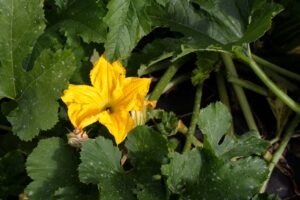
Soil-less Mixes for Vegetable Seedling Production
by Eric Sideman, PhDMOFGA’s Organic Crop Specialist Emeritus Farmers developed soil-less mixes for use in containers for seedlings because field soil does not work well. Soil alone is heavy and poorly aerated. It tends to become waterlogged and sticky when wet. Then it shrinks when it dries, pulls away from the container edges and turns
Providing Nitrogen to Organic Crops
by Eric Sideman, PhDMOFGA’s Organic Crop Specialist Emeritus Nitrogen is usually the nutrient that is in limiting supply, i.e., the limiting factor to crop growth on organic farms. Plants deficient in nitrogen are stunted, yellowish (especially the lower leaves), and have restricted root growth. Plants turn yellow because nitrogen is an integral part of chlorophyll,
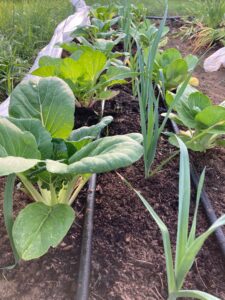
Basics of Organic Vegetable Gardening
Prepared byDr. Eric Sideman andDr. Jean English Introduction The science of gardening is complex, but the actual practice is simple. The central goal of organic gardening is to maintain or improve the ability of the soil to support plant life as it produces a crop of vegetables each year. That ability depends on a dynamic
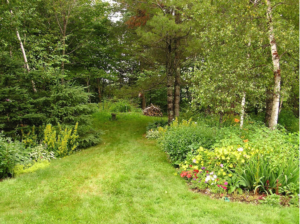
Establishing and Caring for an Organic Lawn
The cool climate of Maine favors healthy lawns. The grass will grow lush and with few problems as long as basic plant needs are met, including proper soil fertility, soil structure, soil organic matter and proper watering and mowing You don’t need synthetic pesticides or fertilizers for a quality lawn, and such synthetic chemicals can
Garden Weeds
by Eric Sideman, PhDMOFGA’s Organic Crop Specialist Emeritus Garden weeds are simply plants that are growing where you do not want them. Any plant species may be a weed, but in gardens in New England, there are some species that are very common. And, in some gardens, very common is an understatement. Why do some
Composting in the Back Yard or on a Small Farm
by Eric Sideman, PhDMOFGA’s Organic Crop Specialist Emeritus Composting is a natural, biological process in which microorganisms use organic materials as food and leave a residue of digested organic matter that is almost completely decomposed. Composting is the same as the decomposition that happens to all living things when they die, except that you control
An Introduction to the Physical Nature of Soils
by Eric Sideman, PhDMOFGA’s Organic Crop Specialist Emeritus Benefits of Composting The soil is a complex and dynamic system of living and nonliving components. In natural ecosystems, minerals cycle from living back to non-living components, while organic matter levels remain relatively constant as deposits of organic matter (from falling leaves, for example) balance decomposition. In
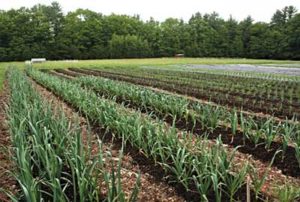
Ridge Tillage at Hackmatack Farm
By Nicolas LindholmPhotos and illustrations by Nicolas Lindholm Ridge tillage as we practice it at Hackmatack Farm is a system of growing vegetable crops in raised ridges formed before planting. Essential to this system is incorporation of winterkilled cover crops and other organic matter into the top surface layer of soil as we form the
Zone Tillage – A Reduced Tillage Option for Northern Farms
By Jan Goranson and Rob Johanson, Goranson Farm, Dresden, and Jean English, Ph.D., MOFGA Plowing and tilling soil excessively can reduce soil health by exposing soil to so much aeration that organic matter oxidizes excessively; subjecting soil to wind and water erosion; inverting soil layers, thus displacing soil organisms from their ecological niches. Plowing and
Organic Strawberry Production
by Eric Sideman, PhDMOFGA’s Organic Crop Specialist Emeritus Introduction Similar to any organic crop production, producing strawberries organically entails a system approach to the whole farm. Many of the practices are the same in organic and conventional strawberry systems, but the fundamental approach to soil husbandry and pest management may be quite different. Successful organic
Storing Garden Vegetables
by Eric Sideman, PhD and Cheryl Wixson, P.E. Apples Use caution when storing apples with other vegetables as they give off ethylene gas that causes other vegetables to rot. They can be stored in tubs with lids to prevent this effect. Choose varieties that are good winter keepers, like golden russet, Belle de Boskeep, winter
Natural Sources of Plant Nutrients
by Eric Sideman, PhDMOFGA’s Organic Crop Specialist Emeritus There are two basic approaches to fertilization. The first is to provide required nutrients to each crop in a soluble form that plants can use immediately, i.e., feed the plant. The advantage to this approach is the opportunity to quite accurately meet a crop’s need. The disadvantage
Using Green Manures
by Eric Sideman, PhDMOFGA’s Organic Crop Specialist Emeritus Introduction There is no such thing as the “best green manure”. A grower has to decide what is the most important benefit to their farm system of growing green manures and what is the window of opportunity that they have to take cropland out of production. This
An Organic Farmer’s Guide to the Interpretation of a Standard Soil Test from the University of Maine
by Eric Sideman, PhDMOFGA’s Organic Crop Specialist Emeritusand David Colson, New Leaf Farm Introduction The soil is the source of all but a very small part of a plant’s nutrition. Soil testing is a quick way to assess the nutrient status of your soil and to determine what amendments are needed for an optimal yield
Pest Topics
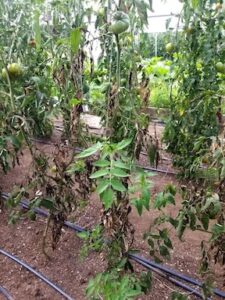
Stemphylium Gray Leaf Spot of Tomato
Pest: Stemphylium Gray Leaf Spot of Tomato Gray leaf spot can be caused by several fungal species in the Stemphylium genus. Stemphylium solani and S. lycopersici are most common in North America, but S. botrysum also causes the disease. Gray leaf spot is typically considered to be most prevalent in humid tropical and subtropical regions,
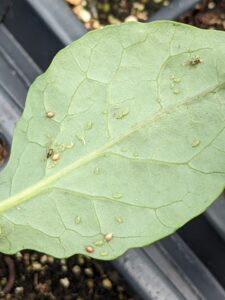
Aphids
Pest: Aphids Aphids are perhaps the soft-bodied insect pest most well-known to both farmers and gardeners. There are many different species of aphids, but green peach (Myzus persicae), melon (Aphis gossypii), potato (Macrosiphum euphorbiae), and foxglove (Aulacorthum solani) are the most common aphid species of concern in the Northeast. Some aphid species may have greater
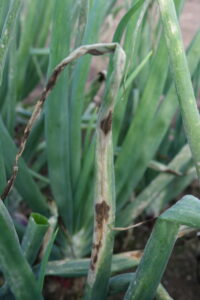
Foliar Diseases of Alliums
Disease(s): Common Foliar Diseases of Alliums This fact sheet discusses botrytis leaf spot (Botrytis squamosa), purple blotch (Alternaria porri), stemphylium leaf blight (Stemphylium vesicarium) and downy mildew of onion (Peronospora destructor). These are the most commonly occurring foliar diseases of alliums in the Northeast, and many of their disease dynamics are closely linked; if one
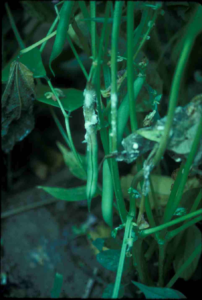
White Mold
Pest: White mold (Sclerotinia sclerotium) Pest/disease lifecycle, most common damage symptoms and crops affected: White mold (Sclerotinia sclerotium) is a widespread disease of over 300 species of plants. It is only a sporadic problem in “normal” and dry growing seasons; however, white mold can be very damaging in wet years and, if it goes unrecognized
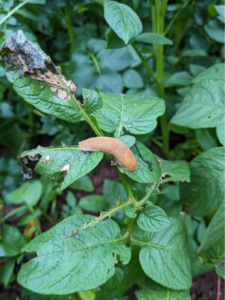
Slugs and Snails
Pest: Slugs and Snails Pest/disease identification and lifecycle, most common damage symptoms and crops affected: Land slugs and snails are closely related mollusks, known together as “gastropods,” the primary difference between them being that snails have external spiraling shells. There are over 90 terrestrial gastropods found in Maine. The gray garden slug is most common
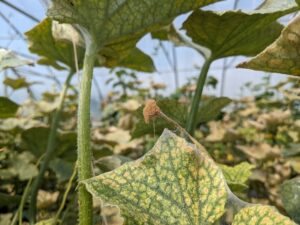
Two-Spotted Spider Mites
Pest: Two-spotted spider mites (Tetryanchus urticae) Pest/disease identification and lifecycle, most common damage symptoms and crops affected: Two-spotted spider mites are the most common mite pest of crops in the Northeast. Because they thrive in hot and dry conditions, they are commonly found in greenhouses and high tunnels. Spider mites can feed on many crops
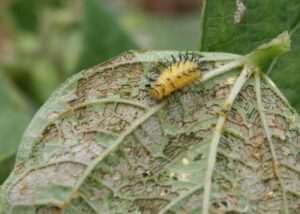
Mexican Bean Beetle
Pest: Mexican bean beetle (Epilachna varivestis) Pest/disease identification and lifecycle, most common damage symptoms and crops affected: If Mexican bean beetles have historically been a problem on your farm or in your garden, you will very likely see them again this year. They may be pests on snap beans, dry beans, soybeans and lima beans.
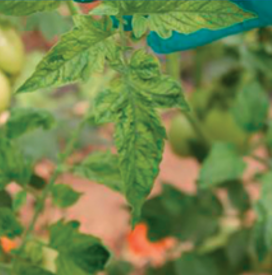
Tomato Brown Rugose Fruit Virus
Pest: Tomato Brown Rugose Fruit Virus (ToBRFV) Disease identification: Tomato brown rugose fruit virus, otherwise referred to as ToBRFV, is a highly virulent and aggressive plant virus that can cause serious infections on tomato and pepper species. ToBRFV behaves very similarly to other tobamoviruses such as ToMV (tomato mosaic virus) and TMV (tobacco mosaic virus).
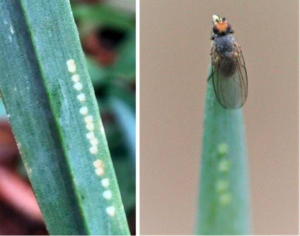
Allium Leafminer
Pest: Allium Leafminer (Phytomyza gymnostoma) Pest/disease identification and lifecycle, most common damage symptoms and crops affected: Allium, or onion, leafminer (ALM) is an invasive pest of alliums. Adult allium leafminers are small (approximately 3 millimeters) gray/black flies with a distinctive orange/yellow spot on the tops of their heads, and yellow “knees” (Fig. 1). ALM have
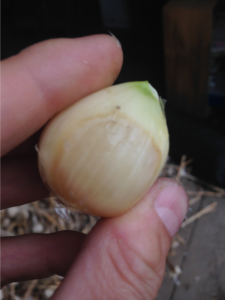
Waxy Breakdown of Garlic
Condition: Waxy Breakdown (an abiotic disorder) Pest/disease identification and lifecycle, most common damage symptoms and crops affected: Waxy breakdown of garlic is a physiological condition that sometimes affects garlic, though typically only rarely in Maine. Development of the condition is not fully understood but often associated with very high temperatures and/or sunscald damage around harvest
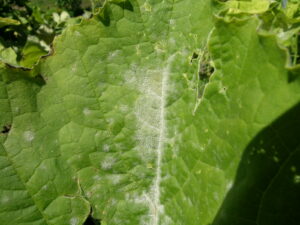
Powdery Mildew of Cucurbits
Disease: Powdery Mildew of Cucurbits (Podosphaera xanthii and Erysiphe cichoracearum) Pest/disease identification and lifecycle, most common damage symptoms and crops affected: Management options: Powdery mildew is a common disease of pumpkins and winter squash. All cucurbits are susceptible, but many common cucumber and melon varieties have had powdery mildew resistance bred into them. The disease
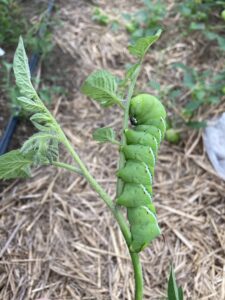
Hornworms
Pest: Hornworms (Manduca sexta, M. quinquemaculata) Pest/disease identification and lifecycle, most common damage symptoms and crops affected: Hornworms are probably the most destructive insect that attacks tomatoes. They are giant caterpillars that grow rapidly and can do a vast amount of eating in a very short amount of time. Sometimes it seems that healthy-looking tomato
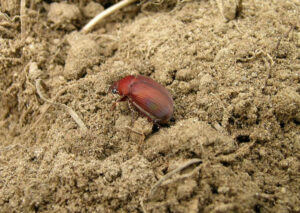
Scarab beetles
Pest: Scarab beetles (Asiatic Garden, Japanese, Oriental, Chafers) Pest/disease identification and lifecycle, most common damage symptoms and crops affected: There are several species of scarab beetles that are common in New England turf, fruit and vegetable crops. These were all introduced to the United States. Japanese beetles are the most common and widely distributed. Below
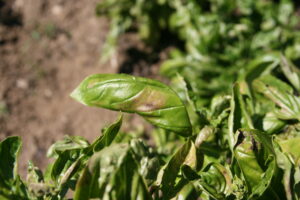
Basil Downy Mildew
Pest: Basil Downy Mildew (Peronospora belbahrii) Pest/disease identification and lifecycle, most common damage symptoms and crops affected: Downy mildew of basil was first reported in Uganda back in 1930. Relatively recently it spread to Italy in 2004, France in 2005, United States (Florida) in 2007 and by 2009 had made its way to New England.
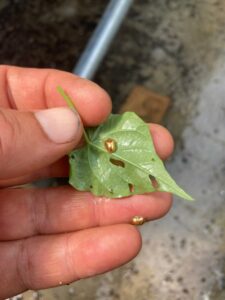
Clavate and Golden Tortoise Beetles
Pest: Tortoise beetle (species in the Cassidinae subfamily) Pest/disease identification and lifecycle, most common damage symptoms and crops affected: There are many species of tortoise beetles globally but only two that are commonly noticed in Maine: clavate tortoise beetle (Plagiometriona clavata) and golden tortoise beetle (Charidotella sexpunctata). Adult tortoise beetles lay their eggs on the
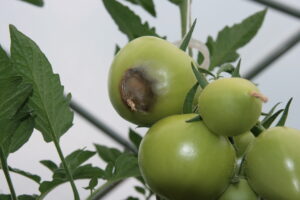
Blossom End Rot
Blossom End Rot Blossom end rot is a familiar sight for many tomato growers, but it can affect other crops as well, such as peppers and squash. Though it may look like a disease, and it sometimes allows infection by secondary decay organisms, blossom end rot is an abiotic growth disorder caused by stressful growing
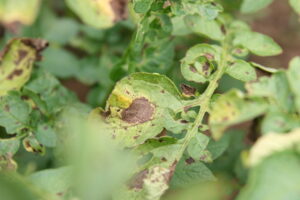
Early Blight
Disease: Early blight on tomato (Alternaria) Pest/disease identification and lifecycle, most common damage symptoms and crops affected: Early blight is a serious problem in tomatoes and potatoes, but rarely affects peppers and eggplants. In most years, it is very common; much more common than late blight, which is usually rare in Maine. All aboveground portions
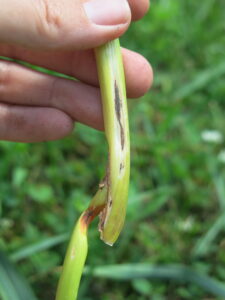
Garlic Anthracnose
Pest: Anthracnose (Colletotrichum fioriniae) Pest/disease identification and lifecycle, most common damage symptoms and crops affected: The fungus pathogen that is responsible for anthracnose on garlic scapes (Colletotrichum fioriniae), is the same fungus that causes celery anthracnose — described in this pest report from 2019. One theory for the relatively recent appearance of the disease is
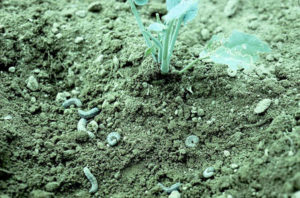
Cutworms
Pest: Cutworms (many species) Pest/disease identification and lifecycle, most common damage symptoms and crops affected: Cutworms are occasional pests of many crops early in the season, including carrots, peas, onions, spinach, broccoli and the list goes on and on. Some years they result in major losses, other years result in no loss at all. They
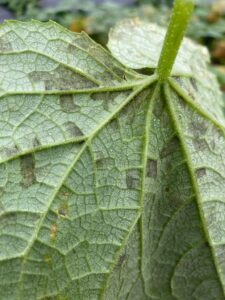
Cucurbit Downy Mildew
Pest: Cucurbit downy mildew (Pseudoperonospora cubensis) Pest/disease identification and lifecycle, most common damage symptoms and crops affected: Cucurbit downy mildew can be very destructive of cucumbers, squash, pumpkins and melons, if conditions are favorable to it. This disease does not overwinter here, and its severity in any given season is often dependent upon when it
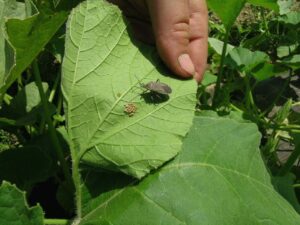
Squash Bug
Pest: Squash Bug (Anasa tristis) Pest identification and lifecycle, most common symptoms and crops affected: Squash bugs are serious pests of pumpkins and squash throughout North America. Plant damage, and bug survival, are low on watermelon, very low on cucumber and muskmelon, and highest on squash and pumpkin. Both adults and nymphs feed by inserting
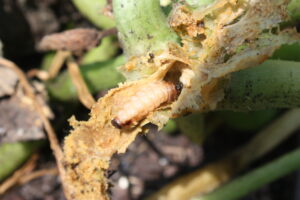
Squash Vine Borer
Pest: Squash vine borer (Melittia cucurbitae) Pest identification and lifecycle, most common symptoms and crops affected: Squash vine borer moths are day-flying moths with a 1 to 1.5 inch wingspan and bright orange-red markings. In flight, they look like wasps. There is thought to be only one generation per year in New England with adults
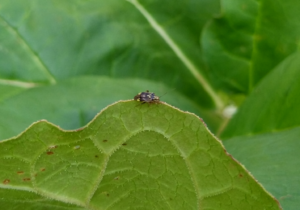
Tarnished Plant Bug and Four-Lined Plant Bug
Pests: Tarnished Plant Bug (Lygus lineolaris) and Four-Lined Plant Bug (Poecilocapsus lineatus) Pest identification and lifecycle, most common symptoms and crops affected: The tarnished plant bug is a small (6 mm), bronze, brown and black bug that feeds on a very wide variety of plants (up to 300 different species). They overwinter as adults under
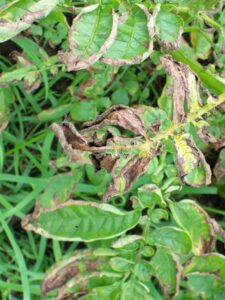
Potato Leafhoppers
Pest: Potato Leafhoppers (Empoasca fabae) Pest identification and lifecycle, most common symptoms and crops affected: The potato leafhopper has been arriving here in New England earlier and earlier. If you see unexplained yellowing of leaves of beans or potatoes, check for the critter. They primarily feed on beans, potatoes, eggplants, strawberries and alfalfa, but will
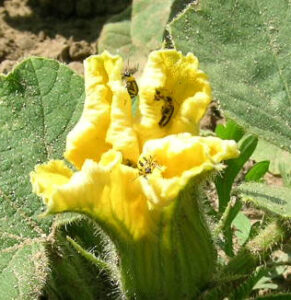
Striped Cucumber Beetle
Pest: Striped cucumber beetle (Acalymma vittatum) Pest/disease identification and lifecycle, most common damage symptoms and crops affected: Striped cucumber beetle is our most serious early-season pest in cucurbit crops. These beetles spend the winter in plant debris in field edges and with the onset of warm days and emergence of cucurbit crops they rapidly move
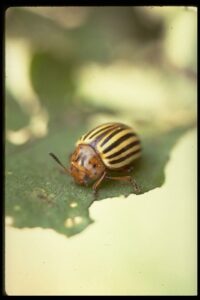
Colorado Potato Beetle
Pest: Colorado Potato Beetle (Leptinotarsa decemlineata) Pest identification and lifecycle, most common symptoms and crops affected: As with most other insects and plants, there is a direct relationship between higher temperatures (in the range between about 55 and 90 degrees) and faster rate of development. That includes egg-laying, egg hatch, larval growth and feeding rates.
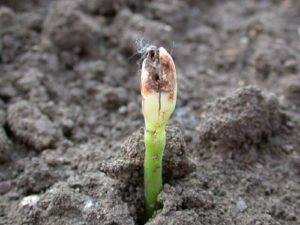
Seedcorn Maggot and Other Maggots
Pests: Seedcorn maggot (Hylemya platura), Onion maggot (Delia antiqua), Cabbage maggot (Delia radicum) Pest identification and lifecycle, most common symptoms and crops affected: Seedcorn maggot larvae feed on seeds and young seedlings of many crops (including corn, beans, beets, peas, spinach, onions and Brassicas). The first symptoms are usually poor germination (or failure of seedlings
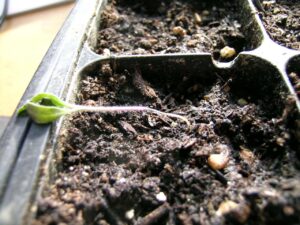
Seedling Problems
In the early spring, when most plants are still in greenhouses — a much more controlled setting than gardens and fields — a lot of the problems that arise are abiotic (i.e., not infectious). Sometimes abiotic issues are transient (e.g., cold temperatures) so it’s good to both check new growth to see how it looks
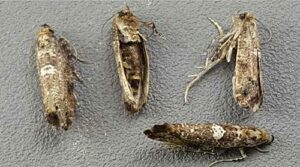
Leek Moth
Pests: Leek Moth (Acrolepiopsis assectella) Pest/disease identification and lifecycle, most common damage symptoms and crops affected: Leek moth is a newer invasive pest of allium crops like onions, garlic, shallots and chives, and, as the name suggests, they are particularly fond of leeks. As with most moth pests the crop damage is from its larval
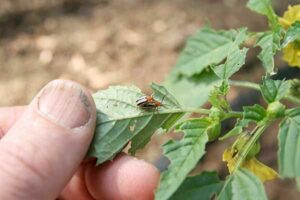
Three-Lined Potato Beetle
Pests: Three-Lined Potato Beetle (Lema daturaphila) Pest/disease identification and lifecycle, most common damage symptoms and crops affected: The favorite foods of the three-lined potato beetle are crop and weed species in the Physalis genus, notably tomatillo and husk cherries. Other solanaceous crops, such as, ashwagandha, eggplant, potato, and tomato are also sometimes attacked.The adult of
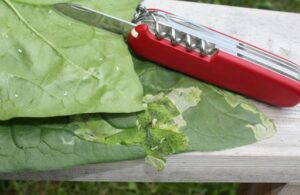
Spinach Leafminer and Beet Leafminer
Pests: Spinach leafminer (Pegomya hyoscyami), Beet leafminer (Pegomya betae) Pest/disease identification and lifecycle, most common symptoms and crops affected: These closely related species of leafminer attack spinach, beet, chard and some weeds, such as lambsquarters. The adult is a fly that lays its eggs on the undersides of leaves. Eggs hatch in as few as
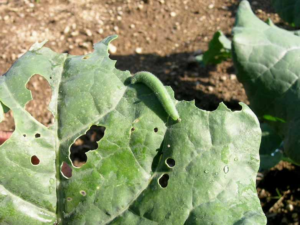
Cabbageworm
Pests: Imported Cabbageworm (Pieris rapae), Diamondback Moth (Platella zylostella), Cabbage Looper (Trichoplusia ni) The first sign of imported cabbageworm is typically one or more white moths with dark marks on their wings fluttering around brassica plants during the day. Also known as cabbage whites, these moths lay ⅛-inch long eggs singly on brassica crop leaves,
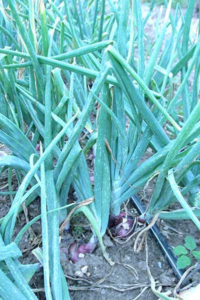
Onion Thrips
Pest: Onion Thrips (Thrips tabaci) Pest/disease Identification and lifecycle, most common symptoms and crops affected: Onion thrips are active already, and if they have been a problem for you in years past it is time to start scouting for them. They are very tiny and easily overlooked until the onion plants start showing leaves that
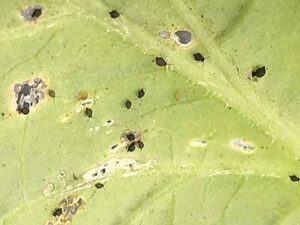
Garden Springtails
Pest: Garden Springtails (Collembolla) Pest/disease identification and lifecycle, most common symptoms and crops affected: Springtails are a very diverse group of soil dwelling arthropods, that largely feed on decaying organic matter. As such, most springtail species are playing a beneficial role in a healthy soil’s food web. That knowledge may be of little relief, however,
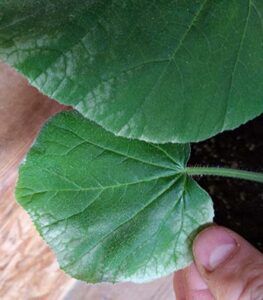
Sunscald/Windwhip
Pest/disease identification and lifecycle, most common symptoms and crops affected: Plants that have not yet been hardened off thoroughly, or can’t get all the water they need, can suffer from something akin to a sunburn. The damage usually shows up first as a bleaching of exposed leaf surfaces, typically higher up on the plant, though

Flea Beetles
Pests: Crucifer Flea Beetle (Phyllotreta cruciferae), Striped Flea Beetle (Phyllotreta striolata), and Solanaceous flea beetles (in the genus Epitrix — E. cucumeris and E. fuscula) Pest/disease identification and lifecycle, most common symptoms and crops affected: In colder climates such as the Northeast, the crucifer flea beetle (Phyllotreta cruciferae) and striped flea beetle (Phyllotreta striolata) are

Asparagus Beetle
Pest: Asparagus Beetle, Common (Crioceris asparigi) and Spotted (Crioceris duodecimpunctata) Pest identification and lifecycle, most common symptoms and crops affected: Common Asparagus Beetle (Crioceris asparigi) Blue-black, shiny, smooth and about 6 to 9 millimeters (1/4 inch) long, with three large yellow, squarish spots with red margins along each wing cover. Eggs are black, laid standing on

Edema
Pest: Edema Pest/disease identification and lifecycle, most common symptoms and crops affected: Edema usually shows up on tomato seedlings when they have been waiting through lots of cloudy cold days. It is also a common problem in plants in the cabbage family, and some house plants. Blisters or bumps appear on the surface of the
Lawn Care

Establishing and Caring for an Organic Lawn
The cool climate of Maine favors healthy lawns. The grass will grow lush and with few problems as long as basic plant needs are met, including proper soil fertility, soil structure, soil organic matter and proper watering and mowing You don’t need synthetic pesticides or fertilizers for a quality lawn, and such synthetic chemicals can
Livestock Topics
Manure Management from Facility to Field
“Farmers are outstanding in their field.” – Unknown Facilities: Barn design Considering barn design in relation to livestock and poultry manure output can be critical. Designing low-cost facilities while balancing their efficiency can depend on species and production considerations. For example, dairy cows create considerable amounts of wet manure and urine, making bedded pack barn
Basic Care of Cattle
Basic biology: Average Body Temperature: 100.5 F Age of sexual maturity: 6 months Heat cycle: 21 days Gestation: 283 days (9 months) Productive life: 10-12 years Digestive system: Ruminant Types of cattle: Dairy – Cattle selectively bred to produce larger volumes of milk than their calves would consume. Beef – Cattle selectively bred to be
Raising Organic Livestock in Maine: MOFGA Accepted Health Practices, Products and Ingredients
By Diane Schivera, MATMOFGA’s Organic Livestock Specialist last updated November 2019 One goal of organic livestock agriculture is to maintain animal health through sound management, and to move away from the regular use of health care products. This list includes both management techniques and materials that are available for use by organic livestock farmers. Information
Raising Organic Pigs
by Diane Schivera, MAT Pigs can be valuable additions to diversified farms by providing meat and helping to clear land. Louis Bromfield wrote in his book From My Experience (1955), “To be financially successful at raising hogs primarily requires the ability to think like a hog.” This article covers the basics of keeping pigs and
Organic Chicken Basics
By Diane Schivera, MAT Introduction The basis for organic livestock production is the development of a harmonious relationship between land, plants, and livestock, and respect for the physiological and behavioral needs of livestock. This is achieved by: Providing good quality organically grown feed Maintaining appropriate stocking rates. Designing husbandry systems adapted to the species’ needs.
Feeding Whole Grains to Chickens
By Diane Schivera, MAT Introduction Feed is the most expensive portion of the cost of raising chickens, and this expense is magnified by the fact that most folks feed a ground mash or pellet that is formulated and produced by a feed company. In an attempt to reduce this cost, you can feed laying hens
Orchards
Apple Orchard Activity Calendar for the Northeast
By C. J. Walke Introduction Growing organic tree fruit can be a bit of a challenge, considering the various insects and diseases that like to call your fruit tree home and the relatively short efficacy window of organic control materials; so being attentive to stages of fruit development and biological cycles of pests in your
Please contact a member of our Farmer Programs team for more information. For information about crops and pests, contact Caleb Goossen. For information about dairy and livestock, contact Jacki Martinez Perkins.
